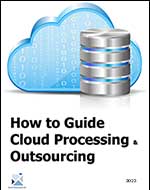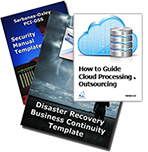 Best use of cloud technology for your business
Best use of cloud technology for your business
Cloud technology has been around for quite some time and has existed in several different incarnations, particularly in the business world. Basically, the term "cloud" refers to a grid of computers serving as an architecture that facilitates the delivery of software and data.
Order Outsourcing and Cloud Policy Download Selected Pages
Computers and servers run applications and power websites, both in the business world and for personal usage. What makes cloud computing different from this "ordinary" system of computing is that the cloud functions as a collective computer that exists in the virtual world. The cloud uses resources and information from computers and servers, running these applications independently and making the specific hardware less important to how the applications work.
Benefits of cloud technology for businesses
The most obvious benefit of cloud technology for a business is increased efficiency; information, resources and applications are accessible to everyone in the business and can be rapidly deployed, saving time and cutting costs. Procurement, purchasing and distribution employees, accounting and customer service staff can all look at the same data, handling daily work issues as well as unique product issues or customer concerns, all gathering the same information from the same central source.
Cloud computing is also highly reliable, deploying the exact same services over and over as required and generating the same result every time. This allows the business to spend less time in trying to improve continuity and handle operational issues and more time on the aspects of business that matter.
The increase in efficiency and business agility permits employees within the business to use their free time more usefully; this benefit is difficult to define and varies for every business, but in general it means that employees may spend less time on the operational issues and more time applying themselves, utilizing their personal assets and helping the company move forward.
Enterprise resource planning
Bringing all the different elements of business functionalities together into a single point is the goal of enterprise resource planning software, or ERP. This software streamlines all the varied processes of a business and pulls them together into a single database. ERP software is available in two forms: on-premise ERP installed directly onto company computers and managed by the company's IT staff; and cloud ERP, which stores software, applications and data in a centrally-managed "cloud" that is accessed via a web browser.
The choice between the two forms of ERP is an important one for any business. On-site ERP can be quite expensive and requires not only the initial investment for the service, but also investment in additional IT personnel and their training. It also requires a good deal of maintenance and service as well as the necessity for manual ERP system upgrades. Cloud ERP, on the other hand, is significantly less expensive to implement and maintain; the provider may upgrade it at will, and it is generally considered faster and more accessible than on-site ERP.
Cloud technology and your business
Today, more and more businesses are choosing to utilize cloud computing technology such as ERP, using it to organize their business processes, improve their ability to produce their products and services, ensuring a higher quality of customer service and enabling them to cut costs along the way.
- Greet each of your employees by name every day. Exchange a few pleasantries and show that you are happy to see them.
- Be positive and always smile
- Use an employee's name when you speak with them. Calling a person by name is one of the most basic ways to show that you respect them as an individual.
- Acknowledge employment anniversaries every year and birthdays. Make sure employees know you value their loyalty.
- At the end of the day, ask at least one employee what went well for them that day. This gives you the opportunity to give immediate reinforcement for good work.
- Complement employees for good work. Each time you compliment an employee, you are encouraging them to continue their good work and to find even better ways to get the job done.
- Ask employees for feedback. Sometimes the best recognition you can give is to simply listen.
- Show employees how much you respect them by sharing key organizational measurements with them on a regular basis.
- Share messages of praise from customers, suppliers, managers and other employees.
- When you implement a suggestion made by an employee, make sure to let their colleagues and your managers know where the great idea came from.



